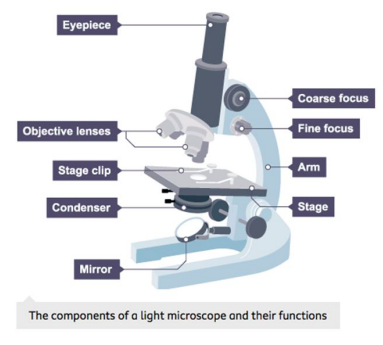Levels of Organisation - U1
Levels of Organisation
Different levels of complexity in which living matter is structured.
Atomic & mollecular level
- All matter is made up of very small elements called atoms
- Atoms come together to form molecules, which are held together by chemical bonds
- Atoms in living matter are called bioelements, which then form biomolecules
- The main bioelements in a human being is known as CHON - carbon, hydrogen, oxygen and nitrogen
| Inorganic | Organic |
|---|---|
| Simple chemical structureFound in both living and non-living matterE.g: water and minerals | Usually made up of a single type of moleculeFound only in living matterE.g: Carbohydrates and lipids |
Organism level
- A tissue is a group of cells which all perform the same function
- Tissues are grouped into organs
- Organs joing together to form organ systems
- Organ systems form a multicellular organism: the human being
Cells & Organelles
| Eukaryotic cells | Prokaryotic cells |
|---|---|
| Larger and more complexHave a nucleusHave organellesSingle-celled or multicellularMultiple linear chromosomes | Smaller and with a simpler structureDon’t have a nucleusDon’t have organellesSingle-celledSingle circular chromosome |
Eukaryotic cells
- Plasma membrane is a thin layer that protects the cell and regulates exchanges of substances
- The nucleus is a large spherical structure that contains genetic material which organises the cell’s activity
- Cytoplasm is formed from a thick aqueous liquid called cyostol that contains different substances and cell organelles. It’s where chemical reactions take place
| Non-membranous organelles | Membranous organelles |
|---|---|
| CentriolesRibosomesCytoskeleton | MitochondriaLysosomesEndoplasmic Reticulum (ER)VesiclesGolgi Apparatus |
- The nuclear membrane contains nuclear pores that allows substances to be exchanged between the nucleus and the cytoplasm
- The nucleoplasm is made up of a thick aqueous liquid which contains DNA
- Chromatin is the network of all DNA fibres and proteins, which then become chromosomes when the cell divides
- The nucleolus is a spherical structure inside the nucleus where the components of ribosomes are made
Cell differentation
- All cells that make up the human body originates from a single celled called zygote
- The cells later become specialised to perform specific tasks
- Differentiation is the process in which the shape and structure of a cell changes in order to perform a specific function
Tissues
A tissue is a group of cells that are specialised to perform the same function
Epithelial tissue
- It’s made up of layers of cells packed together so closely that there is no space between them
Types:
- Covering epithelium covers and protects outside surfaces and internal cavities - mucus membranes
- Glandular epithelium forms glands which are responsible for secreting substances - sweat glands
Connective tissue
- Connective tissue is made up of cells separated by fibres an intercellular substance called matrix
Types:
- Reticular connective tissue has an extensive gel-like matrix that contains abundant fibres, it fills in organs and the spaces between them and forms tendons
- Adipose tissue has a matrix with low levels of intercellular substance, its cells store fat as an energy reserve and for thermal insulation, as its found under the skin
- Cartilaginous tissue has a solid and elastic matrix, and covers the joints to prevent deterioration
- Osseous (bone) tissue has solid and hard matrix, since there are calcium salts present. This tissue forms bones
- Blood has a liquid matrix called plasma which has blood cells suspended in it
Muscle tissue
- Muscle tissue is made up of elongated cells that group together to form muscle fibres that are able to contract and relax. It’s the tissue responsible for body movement
Types:
- Skeletal striated muscle tissue forms the muscles of the locomotor system and can be moved voluntarily
- Cardiac striated muscle tissue forms the walls of the heart. It contracts involuntarily
- Smooth muscle tissue is found in the walls of various organs like the stomach and bladder. It contracts involuntarily
Nervous tissue
Nervous tissue is made up of two types of cells:
- Neurons, which perceive & react to stimuli & control the body’s activity
- Glial cells, which are found amongst neurons and protect & supply them with nutrients
Organs and systems
Systems involved in nutritional functions:
- Digestive: transforms food into nutrients, which are then absorbed into the bloodstream
- Respiratory: exchanges oxygen and carbon dioxide
- Circulatory: uses blood to transport substances throughout the body
- Lymphatic: works together with the circulatory system to transport substances
- Excretory: takes waste substances from the blood and eliminates them from the body
Systems involved in the interaction function:
- Nervous: receives information from the outside environment and generate signals, which then uses to coordinate the body
- Endocrine: works with the nervous system as it generates signals that induce responses in certain organs
- Muscular and skeletal: they make up the locomotor system that’s controlled by the nervous system and generate movement
Systems involved in the reproduction function
- Female reproductive: produces female gametes and nurtures and protects the embryo during its development
- Male reproductive: produces male gametes
Homeostasis: all the physiological processes that keep the internal environment stable
Microscope 
| Optical microscope | Electron microscope |
|---|---|
| Can magnify an image up to 2,500 timesCan be used to study both living and non-living matterImages are seen in colourThere is more than one type of microscopeSpecimens are stained to help identify its parts | Can magnify an image up to 500,000 timesCan only be used to study non-living matterCan’t produce colour imagesTransmission electron micrscopes (TEM) produce 2D imagesScanning electron microscopes (SEM) produce 3D images |